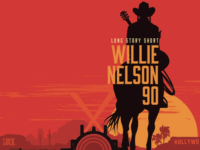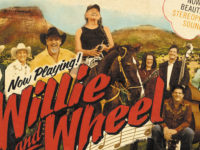Willie Nelson has released five concept albums. They are among his greatest and most confounding works – sometimes simultaneously.
In the mid-1960s, Nelson’s singing career was struggling to take hold. True, earlier in the decade Willie had a Top 10 country hit with “Touch Me.” His songs had been represented on country radio by Faron Young’s recording of “Hello Walls,” George Jones charted with “Family Bible,” and Patsy Cline had a big crossover single with “Crazy.” But by 1968, Willie Nelson’s own career as a performer had stalled.
Nelson would later express frustration about his years at RCA Records, particularly with producer Chet Atkins’ mandate that Willie not use his own band to record. Although unyielding in the studio, Atkins realized that live shows were Willie’s natural setting – and that Texas was the hotbed for his popularity. Atkins wanted to expand that fan base so, in 1966, RCA issued a live recording from Fort Worth called Country Music Concert.
This could be viewed as either an act of inspiration or of desperation. Live albums were a rarity for the record industry at this time — especially for country artists. Groundbreaking or not, this album had little impact on Willie’s career.
Two years later, Chet Atkins had the idea of embracing the Lone Star State in a concept album of regionally related songs. Atkins thought Willie Nelson’s Texas identity might translate to record sales and an increased national presence. It didn’t happen. Although Texas in My Soul is an inventive collection of quality songs, the single “San Antonio” stalled at No. 50 and the album itself did not chart at all.
Like most aspects of his time at RCA, Willie Nelson had little control over this 1968 Texas project. But three years later, he was able to record a very different concept album — one of his own devising called Yesterday’s Wine.
The title sounds like it could be a collection of older hits. But this album was strikingly new in several ways: Yesterday’s Wine is a song cycle that tells the story of a man who, while watching his own funeral, is assessing his life. He speaks of the Perfect Man (presumably Christ), whose voice has already been heard. Now, the voice of the Imperfect Man must be “made manifest.”
The speaker says that he has been chosen as “the most likely candidate” to be this Imperfect Man. He begins by asking God about his purpose on earth. The record then provides a spiritual journey for both the Imperfect Man and the listener. The songs “In God’s Eyes,” “It’s Not for Me to Understand,” and “Going Home” are not among the artist’s best-known works, but Willie Nelson has stated that, of all his albums, Yesterday’s Wine is his favorite.
Yesterday’s Wine is not a casual-listening experience. Willie called it a “loose-fitting suite of songs.” RCA called it “spooky.” The company released it, but declined to promote it. The failure of Yesterday’s Wine caused a frustrated Nelson to retire briefly from the music business. He still had two albums left on his contract, but his enthusiasm had been sapped. He did conclude his RCA obligations in 1972, releasing The Words Don’t Fit the Picture and The Willie Way. Each of these records include some fine Nelson originals, but the albums neither charted nor yielded singles that did well on the radio.
Nelson’s move from RCA to the Atlantic label revitalized the singer. His two albums for Atlantic are the real beginning for the artist who the world would come to know as Willie Nelson. The first was Shotgun Willie. And while it was not a concept record, this 1973 collection of songs points to what lay ahead, including the Outlaw Country genre. Shotgun Willie features the concert staples “Whiskey River,” “Stay All Night,” and the title song. Lesser-known jewels are also here, like “Local Memory.” Nelson could now use his own band to record much of the album, but even while at Atlantic he was not completely rid of string arrangements, which infiltrate “Slow Down Old World” and “So Much to Do.”
As he readied his next Atlantic release, Willie came up with an idea for a third concept album, Phases & Stages. This time, instead of a spiritual narrative, the work would tell a very human story – one of a decaying relationship. A traditional, two-sided record album was the ideal format to present first the woman’s version of events, followed by the man’s perspective.
Although Phases & Stages is more accessible than Yesterday’s Wine, it proved similar to his other concept albums: It didn’t give Willie much radio exposure. “Bloody Mary Morning” would become a concert favorite, but it had the same fate as most of Nelson’s singles, stalling in the lower rungs of the chart. Hit singles or not, Phases & Stages stands as one of Willie Nelson’s strongest albums and, on artistic grounds, his most successful concept album. But artistic merit was not what Willie sought at this point. He wanted a hit, and it came — in spades — with his next endeavor.
After two albums with Atlantic, Willie moved to Columbia Records. What appealed most to Nelson about his new contract was the clause that gave him final say over his releases. This would immediately prove essential. Willie’s first project for Columbia was Red Headed Stranger, another concept album. This one was a song cycle about a man’s love — recounting betrayal, killings, and then renewal.
The recording was sparse, and Columbia executives couldn’t believe that the tape Nelson submitted was meant to be issued as the completed album. They thought it sounded like a demo and insisted that he add more instrumentation to the songs. But Nelson persisted: This was the tape he wanted released, finally pointing to the clause in his contract that gave him complete control. He told the Columbia executives that if the record did poorly, they could tear up his contract. That’s faith.
Red Headed Stranger was released in May 1975. It was different from any other country album of the time. The record’s songs told a story, and the unadorned acoustic accompaniment gave listeners the feeling that Willie was singing only to them. The album’s back cover provided a visual storyboard that helped connect the narrative but, as the single demonstrated, the songs were strong enough to stand on their own.
Like everything else about the Red Headed Stranger project, the song chosen as its single was surprising. It was not a Willie Nelson composition, but one that Fred Rose had written decades earlier called “Blue Eyes Crying in the Rain.” This single was released in July, reaching No. 1 on the country chart and, remarkably, going to No. 21 on Billboard’s pop chart, where Willie had never been before.
“Blue Eyes Crying in the Rain” and the Red Headed Stranger album made Willie Nelson a household name. And now, for the first time, he was a star outside of Texas. It is hard to exaggerate the importance of Red Headed Stranger to Nelson’s career. The success of the album gave Willie a free hand at Columbia, and he used it. Nelson released tribute records, soundtracks, a Christmas album, a two-record live set, and he helped promote the careers of fellow musicians by recording their songs.
Eight years after the breakthrough of Red Headed Stranger, Willie returned to the concept album genre with the song cycle Tougher Than Leather. If the artwork on the back cover of Red Headed Stranger is helpful in following its story, the album graphics for Tougher Than Leather are essential. And even then, the narrative doesn’t gel. The record opens, like Yesterday’s Wine, with a spiritual question. The singer asks the Lord if his earthly existence is payback for something bad he did “a lifetime ago.” Justice is sought, with karma and reincarnation playing important roles in the story.
The setting for Tougher Than Leather is “Somewhere in Texas,” where a young man who could have stepped out of “Don’t Take Your Guns to Town” is shot dead by an aging gunfighter. Remorse, grieving, and revenge are all present here — but to little effect. With three songs about roses — one borrowed from Yesterday’s Wine — flower imagery plays a central role in the Tougher Than Leather story, but this symbol is nonetheless indecipherable. “Nobody Slides, My Friend” suggests that we are all judged for our actions and will be held accountable. “Changing Skies” reminds us that we can’t run away from ourselves. These are worthy themes, but the songs containing such insights are not especially memorable, in spite of the album’s “Little Old Fashioned Karma” making the country Top 10. The songs simply don’t hold this narrative together.
Nelson himself may not have been completely satisfied with Tougher Than Leather for, after featuring the album prominently on a 1983 HBO concert special, the songs quickly evaporated from Willie’s live shows. Some 37 years since arriving via Columbia Records, Tougher Than Leather remains Nelson’s most recent concept album – and one of his least-known studio projects.
Through it all, Willie Nelson has continued to play live shows. There are songs he sings every night, but some parts of his set are in constant flux. It is thought that Willie did not perform Yesterday’s Wine in concert as a song cycle, but set lists from this era of his career are difficult to obtain. He would often play a medley of specific selections from Phases & Stages, but not the entire album. Nelson would frequently perform all of side one of Red Headed Stranger. He apparently views these linked songs as a single composition, for at the conclusion of a 1974 performance of this material in Dallas, Willie thanked the audience for listening attentively to “that long song.” He has far less frequently performed side two of Red Headed Stranger and, surprisingly, very rarely sings “Hands on the Wheel,” a strong number near the end of the album. To this day, Nelson regularly plays sections of his most famous concept album at concerts.
Willie appears uninterested in releasing collections of unrelated songs. The man likes to construct a theme for his albums. He recorded a collection of standards, Stardust, and the heartfelt tribute records From Willie to Lefty (Frizzell) and You Don’t Know Me: The Songs of Cindy Walker. His religious themed albums include The Troublemaker and Farther Along: The Gospel Collection.
He has also been involved with a myriad of duet projects. This latter category is a wide one, where Willie shares the microphone with both the famous and the nearly forgotten. His duet albums with Ray Price and with Leon Russell are favorites of the Willie Nelson catalog, while duet releases with Webb Pierce, guitarist Jackie King, and with golf pro Don Cherry are virtually unknown.
There is a wide world of Willie music out there yet to explore: Concept albums are just the start.
Tom Wilmeth is a freelance writer who lives in Grafton, Wisconsin — former home of the Paramount Records label. He is the author of ‘Sound Bites: A Lifetime of Listening’ (Muleshoe Press, 2016). Available at Amazon.
- Dickey Betts’ Star Rose as the Allman Brothers Band Grieved - April 19, 2024
- ‘Drums & Demons: The Tragic Journey of Jim Gordon,’ by Joel Selvin (2024): Books - March 12, 2024
- Robby Krieger – ‘Robby Krieger and the Soul Savages’ (2024) - February 26, 2024




